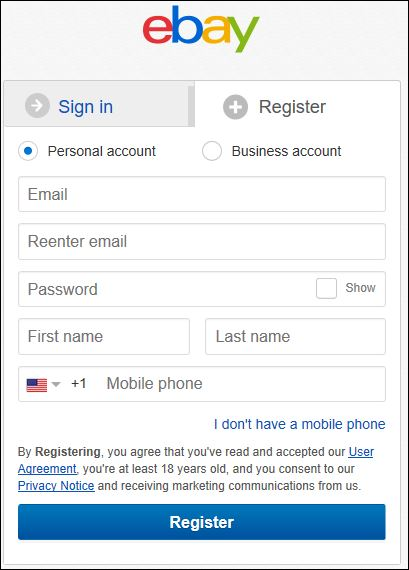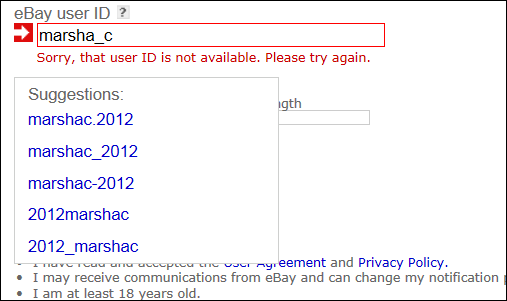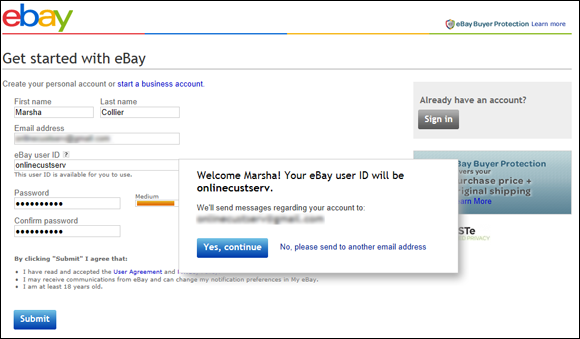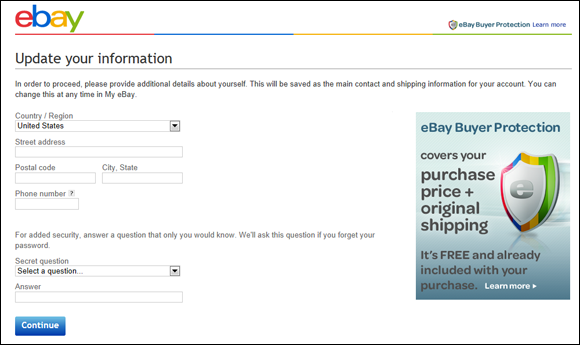Chapter 3
Signing Up and Getting Started
IN THIS CHAPTER
![]() Registering with eBay
Registering with eBay
![]() Choosing a password
Choosing a password
![]() Selecting a User ID
Selecting a User ID
![]() Signing in
Signing in
![]() Following eBay’s rules
Following eBay’s rules
The prospect of getting started on eBay is exciting — and daunting. Perhaps you’ve visited the eBay website once or twice with the idea that you might buy something. Maybe you’ve heard your friends talk about the things they’ve bought. Did you look up something simple, such as a golf club? Did eBay come up with several thousand listings? Or maybe you figured you’d get smart and narrow the search down to a 3 iron, but you still got more than a thousand listings?
Did you consider buying something and then just left the site, for fear you’d get ripped off? eBay works much better for me than any quasi-convenient TV shopping. On eBay, you have the opportunity to give an item a leisurely once-over, read the description and terms, and click a link to ask the seller a question before you bid or buy — and there’s eBay’s Money Back Guarantee! That’s the great thing about eBay: There’s always another seller — and always another item.
Registering on eBay
You can browse eBay all you want without registering, but before you transact any sort of business on eBay, you must register. I recommend registering right now — while you’re reading this book.
You don’t have to be a rocket scientist to become a member on eBay. The only hard-and-fast rule is that you have to be 18 or older. Don’t worry; the Age Police won’t come to your house to card you — they have other ways to discreetly ensure that you’re at least 18 years old. (Hint: Credit cards do more than satisfy account charges.)
If you’re having a momentary brain cramp and you’ve forgotten your age, just think back to your childhood. If your first memory is watching Saved by the Bell on TV, you’re in. Head to the eBay home page and register. The entire process takes only a few minutes.
Before you can sign up, you have to be connected to the web, so now’s the time to fire up your computer. After you open your Internet browser, you’re ready to sign up. In the address box of your browser, type www.ebay.com and press Enter.
Your next stop is the eBay home page. Right there, where you can’t miss it, is the Hi! Sign In or Register set of links. Click the word register and let the sign-up process begin.
When you’re at the Registration form, you go through a three-step process. Here’s an overview:
- Enter the basic required info.
- Read and accept the User Agreement.
- Confirm your email address.
The following sections fill you in on all the details.
You register on eBay through an encrypted (supersecret) connection called SSL (Secure Sockets Layer). You can tell because the normal http at the beginning of the web address is now https.
The SSL certificate verification (in a lower corner of the Get Started on eBay page) means that eBay is a secure place that is safe from unauthorized people seeing or receiving your information. Your information is treated with the highest security, and you can fill out these forms with the utmost level of confidence. I could tell you how SSL works, but instead I'll just give you the bottom line: It does work, so trust me and use it. The more precautions eBay (and you) takes, the harder it is for some hyper-caffeinated kid to get into your data.
Filling in required information
After you click the Register link, you go to the first registration page. At the top of the page, you will see that you are creating a personal account. If you’d prefer to start a business account, click the appropriate link. Why not start with a personal account — just to get your feet wet. eBay asks you to fill in some required information (see Figure 3-1).

FIGURE 3-1: Required information for your eBay registration.
https://scgi.ebay.com/ws/eBayISAPI.dll?ChangeRegistrationAccountType
To get started, follow these steps:
-
eBay needs to know stuff about you. Enter the following information:
- Your full name
- Your mobile phone number
- Your email address (
[email protected])
 If you register with an anonymous email service such as Yahoo!, Gmail, or Hotmail, you may go to a page that requires additional information for authentication. You must provide valid credit card information for identification purposes. Your information is protected by eBay's privacy policy, and your credit card won’t be charged.
If you register with an anonymous email service such as Yahoo!, Gmail, or Hotmail, you may go to a page that requires additional information for authentication. You must provide valid credit card information for identification purposes. Your information is protected by eBay's privacy policy, and your credit card won’t be charged.After you input your personal information, you’re ready to create your eBay persona.
-
Type in your new eBay User ID.
Your User ID is the name that will be shown to other users when you bid, buy, or sell. But don’t strain your brain too much right now over your choice of User ID. You can change your User ID once every 30 days. (See “Selecting Your User ID,” later in this chapter, for some tips on making your selection.) If your chosen ID is already taken, eBay has a handy tool to help you select another one, as shown in Figure 3-2.
-
Choose a password, enter it in the Password box, and then type it a second time in the Confirm Password box to confirm it.
The best passwords for eBay or any website are more than six characters long and include a combination of letters (upper- and lowercase) and numbers. Never use your User ID, name, pet’s name, address, birthdate, or anything that may be easily known by others. C’mon, get a little cagey. For more information on choosing your password, see “Picking a Pickproof Password,” later in this chapter.
- Read the not-so-fine print and click the Register button.

FIGURE 3-2: eBay’s instant User ID suggestion form.
At this point, eBay tells you that they will send an email to your email address for confirmation (see Figure 3-3). If that’s OK, click the Yes, Continue button. If you’d prefer the email be sent to a different email address, click the No, Please Send to Another Email Address link. eBay will prompt you to type the alternate email address in the original Email Address text box. So give them the correct one the first time.

FIGURE 3-3: Clicking Submit will help confirm your email address.
The upcoming section will tip you in on what to expect in the “fine print.”
Do you solemnly swear?
After you fill in your required information and scroll down, you should click the links to see the eBay User Agreement and Privacy Policy. At this page, you take an oath to keep eBay safe for democracy and commerce. You promise to play well with others, to not cheat, and to follow the golden rule. No, you’re not auditioning for a superhero club, but don’t ever forget that eBay takes this stuff seriously. You can be kicked off eBay or worse. (Can you say, “federal investigation”?)
Be sure to read the User Agreement thoroughly when you register. So that you don’t have to put down this riveting book to read the legalese right this minute, I provide the nuts and bolts here:
- You understand that every transaction is a legally binding contract. (Click the User Agreement link at the bottom of any eBay page for the current eBay rules and regulations.)
- You agree that you can pay for the items you buy and the eBay fees that you incur.
- You understand that you’re responsible for paying any taxes.
- You’re aware that if you sell prohibited items, eBay can forward your personal information to law enforcement for further investigation.
- eBay makes clear that it is just a venue, which means it’s a place where people with similar interests can meet, greet, and do business.
When everything goes well, the eBay website is like a school gym that opens for Saturday swap meets. At the gym, if you don’t play by the rules, you can get tossed out. But if you don’t play by the rules at eBay, the venue gets un-gymlike in a hurry. But fair’s fair; eBay keeps you posted by email of any updates in the User Agreement.
If you’re a stickler for fine print, head to pages.ebay.com/help/policies/overview.html for all the Ps and Qs of the latest policies.
Your license to deal (almost)
You are now officially a newbie, or eBay rookie, licensed to shop to your heart’s content on the site. The only problem is that you’re still at the window-shopping level. If you’re ready to go from window shopper to item seller, just click the Sell button in the navigation bar. You’ll have to fill out a few more forms, shown in Figure 3-4, and before you know it, you can start running your own sales on eBay.

FIGURE 3-4: Fill out more details to register to sell on the site.
eBay will ask for your business address and phone number, and ask you to create your secret question and input the answer. Once you’ve filled that out, click Continue. You’re brought to the Sell Your Item page.
Picking a Pickproof Password
Choosing a good password is not as easy (but is twice as important) as it may seem. Whoever has your password can (in effect) “be you” at eBay — running auctions, bidding on auctions, and leaving possibly litigious feedback for others. Basically, such an impostor can ruin your eBay career — and possibly cause you serious financial grief.
As with any online password, you should follow these commonsense rules to protect your privacy:
- Don’t choose anything too obvious, such as your birthday, your first name, or (never use this) your Social Security number. (Hint: If it’s too easy to remember, it’s probably too easy to crack.)
- Do make things tough on the bad guys — combine numbers, letters (use uppercase and lowercase), and symbols — or create a punctuated phrase (maybe a quote from your favorite movie?).
- Don’t give out your password to anyone — it’s like giving away the keys to the front door of your house.
- Do change your password immediately if you ever suspect someone has it. You can change your password by going to the Account Information area of your My eBay page or to the following address:
signin.ebay.com/ws/eBayISAPI.dll?ChangePasswordAndCreateHint - Do change your password every few months just to be on the safe side.
Selecting Your User ID
Making up a User ID is always a pleasant chore. If you’ve never liked your real name or never had a nickname, here’s your chance to correct that situation. Choose an ID that tells a little about you. Of course, if your interests change, you may regret too narrow a User ID.
You can call yourself just about anything, but remember that this ID is how other eBay users will know you. Here are some guidelines:
- Don’t use a name that would embarrass your mother.
- Don’t use a name with a negative connotation, such as scam-guy. If people don’t trust you, they won’t buy from you.
- Don’t use a name that’s too weird, you know, something like baby-vampire-penguin. People may chuckle, but they may also question your sanity.
- Remember that eBay doesn’t allow spaces in User IDs, so make sure that the ID makes sense when putting two or more words together. A friend of mine intended to register as “gang of one.” She forgot the hyphens, so her ID reads gangofone.
eBay also has some User ID rules to live by:
- No offensive names (such as &*#@guy).
- No names with eBay in them. (It makes you look like you work for eBay, and eBay takes a dim view of that.)
- No names with & (even if you do have both looks&brains).
- No names with @ (such as @Aboy).
- No symbols, such as the greater than or less than symbol (> <), and no consecutive underscores (__).
- No IDs that begin with an e followed by numbers, an underscore, a hyphen, a period, or dot (as in dot.com).
- No names of one letter (such as Q from Star Trek).
When you choose your User ID, make sure that it isn’t a good clue for guessing your password. For example, if you use Natasha as your User ID, don’t choose Boris as your password. Even Bullwinkle could figure that one out.
Signing In to Deal
You don’t have to wear one of those tacky “Hello, my name is” stickers on your shirt, but you and several million other folks will be roaming around eBay’s online treasure trove. eBay needs to know who’s who when we’re browsing. So, keeping that in mind, sign in when you first go on to the eBay website, please! By clicking Sign In on the eBay home page, you’re ready to shop or sell.
Here’s how to get to the eBay Sign In page and sign in:
- Click the Sign In link near the eBay logo on the eBay home page.
- Enter your User ID and password.
- Click the Sign In button.
You’re now signed in to eBay and can travel the site with ease. You may go to your My eBay page’s eBay Preferences to tell eBay where you want to land after you sign in.
eBay’s Trust & Safety Is Watching
The Security Center is where eBay’s Trust & Safety gurus focus on protecting the website from members who aren’t playing by the rules. Through this department, eBay issues warnings and policy changes — and in some cases, it gives eBay bad guys the old heave-ho.
You can find eBay’s Security Center by clicking the Security Center link at the bottom of most eBay pages. The Security Center page is more than just a link to policies and information. It also connects you to a customer support database. eBay staffers look at complaints on a case-by-case basis, in the order they receive them. Most complaints they receive are about these problems:
- Shill bidders (see the section on “Selling abuses” in this chapter)
- Feedback issues and abuses (see the section on “Feedback abuses” in this chapter)
Staying Notified about the Rules
For an up-close online look at eBay’s rules and regulations, click the Policies link (which is at the bottom of most eBay pages) and then read the User Agreement. (The agreement is revised regularly, so check it often.)
To visit the User Agreement page, go to
http://pages.ebay.com/help/policies/user-agreement.html
If you plan on being an active eBay member, it’s probably worth your while to regularly check eBay’s announcements at
http://community.ebay.com/t5/Announcements/bg-p/Announcements
You can also find a link in the footer of eBay pages.
Abuses You Might Report
Before you even consider blowing the whistle by reporting someone who (gasp!) gave you negative feedback to Trust & Safety, make sure that what you’re encountering is actually a misuse of eBay. Some behavior isn’t nice (no argument there), but it also isn’t a violation of eBay rules — in which case, eBay can’t do much about it. The following sections list the primary reasons you may start investigations.
Selling abuses
If you’re on eBay long enough, you’re bound to find an abuse of the service. It may happen on an auction you’re bidding on, or it may be one of the sellers who compete with your listings. Stay safe and be on the lookout for the following:
- Shill bidding: A seller uses multiple User IDs to bid, or has accomplices place bids to boost the price of his or her auction items. eBay looks for telltale signs, including a single bidder putting in a really high bid, a bidder with really low feedback but a really high number of bids on items, a bidder with low feedback who has been an eBay member for a while but who’s never won an auction, or excessive bids between two users.
- Auction interception: An unscrupulous user, pretending to be the actual seller, contacts the winner to set up terms of payment and shipping in an effort to make off with the buyer’s payment. This violation can be easily avoided by paying with PayPal directly through the eBay site.
- Fee avoidance: A user reports a lower-than-actual final price or illegally submits a Final Value Fee credit. (I explain Final Value Fees in Book 3, Chapter 1.)
- Bid manipulation: A user, with the help of accomplices, enters dozens of phony bids to make the auction appear to have a lot of bidding action. Let the experts at eBay decide on this one; but you may wonder if loads of bids come in rapid succession but the price moves very little.
Bidding abuses
If you want to know more about bidding in general, see Chapter 6. Here’s a list of bidding abuses that eBay wants to know about:
- Bid shielding: Two users work in tandem. User A, with the help of accomplices, intentionally bids an unreasonably high amount and then retracts the bid in the closing moments of the auction — leaving a lower bid (which the offender or an accomplice places) as the winning bid.
- Bid siphoning: Users send email to bidders of a current auction to offer the same merchandise for a lower price elsewhere.
- Auction interference: Users warn other bidders through email to stay clear of a seller during a current auction, presumably to decrease the number of bids and keep the prices low.
- Bid manipulation (or invalid bid retraction): A user bids a ridiculously high amount, raising the next highest bidder to the maximum bid. The manipulator then retracts the bid and rebids slightly over the previous high bidder’s maximum.
- Unpaid item (nonpaying bidder): No matter how eBay chooses to couch it by fancy verbiage, I call these bidders deadbeats. The bottom line is that these people win auctions but never pay.
- Unwelcome bidder: A user bids on a specific seller’s auction despite the seller’s warning that he or she won’t accept that user’s bid (as in the case of not selling internationally and receiving international bids). This practice is impolite and obnoxious. If you want to ban specific bidders from your auctions, you can exclude them in your My eBay area links.
Feedback abuses
All you have at eBay is your reputation, and that reputation is made up of your feedback history. eBay takes any violation of its feedback system seriously. Because eBay’s feedback is transaction-related, unscrupulous eBay members find that manipulating the system is much harder. Here’s a checklist of feedback abuses that you should report to Trust & Safety:
- Feedback extortion: A member threatens to post negative feedback if another eBay member doesn’t follow through on some unwarranted demand.
- Personal exposure: A member leaves feedback for a user that exposes personal information that doesn’t relate to transactions on eBay.
-
 –4.3 feedback: Any user reaching a net feedback score of –4.3 is subject to suspension.
–4.3 feedback: Any user reaching a net feedback score of –4.3 is subject to suspension.
Identity abuses
Who you are on eBay is as important as what you sell (or buy). eBay monitors the identities of its members closely — and asks that you report any great pretenders in this area to the Security Center. Here’s a checklist of identity abuses:
- Identity misrepresentation: A user claims to be an eBay staff member or another eBay user, or registers under the name of another user.
- False or missing contact information: A user deliberately registers with false contact information or an invalid email address.
- Underage: A user falsely claims to be 18 or older. (You must be at least 18 to enter into a legally binding contract.)
- Dead or invalid email address: When emails bounce repeatedly from a user’s registered email address, chances are good that the address is dead. Usually return email indicates that the address is unknown.
- Contact information: One user publishes another user’s contact information on the eBay site.
Operational abuses
If you see someone trying to interfere with eBay’s operation, eBay staffers want you to tell them about it. Here are two roguish operational abuses:
- Hacking: A user purposely interferes with eBay’s computer operations (for example, by breaking into unauthorized files).
- Spamming: The user sends unsolicited commercial email to eBay users.
Miscellaneous abuses
The following are additional problems that you should alert eBay about:
- A user is threatening physical harm to another eBay member.
- A person uses racist, obscene, or harassing language in a public area of eBay.
Don’t Get Caught in a Trading Violation
Playing by eBay’s rules keeps you off the Security Center radar. If you start violating eBay policies, the company’s going to keep a close eye on you. Depending on the infraction, eBay may be all over you like jelly on peanut butter. Or you may safely lurk in the fringes until your feedback rating is lower than the temperature in Nome in November.
Here’s the docket of eBay no-no’s that can get members flogged and keelhauled — or at least suspended:
- Feedback rating of –4.3
- Three instances of deadbeat bidding
- Repeated warning for the same infraction
- Feedback extortion
- Bid shielding
- Unwelcome bidding after a warning from the seller
- Shill bidding
- Auction interception
- Fee avoidance
- Fraudulent selling
- Identity misrepresentation
- Bidding when younger than age 18
- Hacking
- Physical threats

 During the early days of online trading, I was selling Star Trek memorabilia on Auction Web (the original eBay site) and doing quite well. I ran into William Shatner (Captain Kirk of Star Trek fame) at a marketing meeting in mid-1997. Anxious to let him know how well I was doing with my merchandise online, I tried to explain Auction Web (soon to become the awesome eBay). Shatner scoffed, “No one will ever make any money on the Internet.” (Really, I have witnesses — remember, this is the future Mr. Priceline.com.) Ah, well. The future is full of surprises.
During the early days of online trading, I was selling Star Trek memorabilia on Auction Web (the original eBay site) and doing quite well. I ran into William Shatner (Captain Kirk of Star Trek fame) at a marketing meeting in mid-1997. Anxious to let him know how well I was doing with my merchandise online, I tried to explain Auction Web (soon to become the awesome eBay). Shatner scoffed, “No one will ever make any money on the Internet.” (Really, I have witnesses — remember, this is the future Mr. Priceline.com.) Ah, well. The future is full of surprises. You can change your personal eBay account from a personal into a business account when and if you decide it’s time. A quick link to that page is
You can change your personal eBay account from a personal into a business account when and if you decide it’s time. A quick link to that page is  You can change your User ID once every 30 days if you want to, but I don’t recommend it because people come to know you by your User ID. If you change your ID, your past does play tagalong and attaches itself to the new ID. But if you change your User ID too many times, people may think you’re trying to hide something.
You can change your User ID once every 30 days if you want to, but I don’t recommend it because people come to know you by your User ID. If you change your ID, your past does play tagalong and attaches itself to the new ID. But if you change your User ID too many times, people may think you’re trying to hide something.